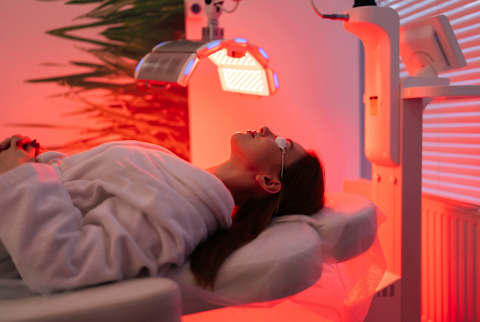Advertisement
Does Red Light Therapy Actually Work? A Top MD Explains The Research


“When I first saw red light therapy, I thought it was complete voodoo,” says Jaime Seeman, M.D., a board-certified OB-GYN who is Head Team Physician of the Omaha Supernovas (a professional volleyball team based in Omaha, Nebraska), and member of mindbodygreen’s scientific advisory board. “But like anything, I wanna see what the science says. So I go to PubMed and I'm looking at research, I'm like, ‘This is really interesting…’”
Red light therapy has been part of the wellness and beauty zeitgeist for several years now—establishing itself as a mainstay gadget for longevity hackers and people in-the-know. You can find options in hand-held wands and wearable masks to full-body LED beds and panels. As for why health experts say they use the tools, you’ll hear everything from “firming skin” to “improving joint pain.”
Usually when a type of technology becomes this popular this fast—and comes with such a wide and varied assortment of benefits—it’s reason to give pause. A golden rule for the wellness industry is: If it sounds too good to be true, it usually is.
So when a no-nonsense, research-obsessed physician like Seeman expresses her support (says she’s a user herself!), obviously our interests were piqued.
At this year’s Revitalize summit in Miami, Seeman joined mindbodygreen co-founder and co-CEO Jason Wachob to discuss her well-being must-haves—including red light therapy.
What is red light therapy & how does it work?
Red light therapy (RLT)—also known as red LED light therapy, low-level light therapy (LLLT), photobiomodulation, and cold laser therapy—uses specific wavelengths of red and near-infrared light to stimulate the body at a cellular level. Unlike UV light, which can damage the skin, red and near-infrared wavelengths (at wavelengths of 660 nm and 890 nm) penetrate deep into the tissue and offer restorative benefits.
As Seeman explains, "We are receivers of light. We're biological creatures, just like trees and plants. We get energy from the sunlight." Indeed, red light works via a phenomenon called photobiomodulation.
The exact mechanisms of photobiomodulation are not completely understood, but the effects have been clinically studied1: "Red light increases mitochondrial energy, reduces inflammation, and reduces oxidative stress," she says, referencing how it's believed to work in the body.
Why this MD supports red light therapy
By improving cellular function, the body can experience a host of benefits. Here are a few that Seeman boasts:
- Thyroid support: "I started doing red light therapy because I had hypothyroidism. You can red light the thyroid gland," she shares. While not a replacement for medical treatment, clinical evidence suggests that red light may help support healthy function in some people with thyroid concerns, like hypothyroidism.
- Improves skin: One of its most famous use cases is in skin care. "Some people love to red light the face because it helps stimulate fibroblasts to make collagen," she says. Research shows that with regular use red light therapy can help smooth wrinkles and firm skin—as well as other aesthetic benefits such clear blemishes, and reduce the appearance of redness.
- Hair growth: “You can red light the scalp,” she notes, which has been shown to improve hair growth when using wavelengths of 650 nm.
- Women’s health: As an OBGYN, Seeman also sees potential benefits for women’s health concerns: “There's some interesting research for things like menstrual cramps, endometriosis,” she says.
Plus, Seeman notes, it’s pretty easy to fit into your schedule—even for an otherwise busy woman like herself. "You can sit there and do breathwork — I multitask when I red light because I don’t sit still very well. I’ll sit on the floor and work while I red light, so now I’m habit stacking to the core,” she says.
Find a tool that works for you
Here’s the deal: If you want to reap the benefits of red light therapy, you need to make sure you’re using a quality device.
"Some brands just use red bulbs, so make sure you know what kind of red light they’re using. Don’t pay for a red bulb—look for a device with specific wavelengths of near red and infrared light."
How can you tell that the brand is quality? Some signs:
- The mask has been FDA-cleared
- They’ve performed clinical studies
- The website prioritizes education
- The brand is transparent about the exact wave length, number of bulbs, and irradiance
- They’re expert backed by scientists, physicians, dermatologists or estheticians
But be warned: These pro-worthy tools come with a price tag to match. That’s why LED masks are so expensive, because you’re paying for the vetted technology. "Red light units aren’t cheap, but the science is real,” Seeman agrees.
If you want some pre-vetted tools, here are the ones that mindbodygreen editors have tested and use:
- Our comprehensive list of the best LED tools
- The red light wand our editor swears by
- This red light panel improved our tester’s sleep score
- The 5 best face masks vetted by beauty experts
- An editor’s review of the Bon Charge panel after using it for 2 weeks
The takeaway
Red light therapy isn’t a miracle cure, but according to Seeman—and an expanding body of research—it can be a powerful tool in a comprehensive wellness toolkit. “I’m a huge fan—it’s not voodoo."